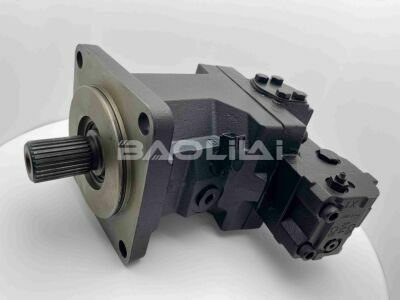Internal leakage of hydraulic motors is inevitable
Internal leakage of hydraulic motors is a common phenomenon, and due to the design and operating principles of hydraulic systems, internal leakage can be considered inevitable. Hydraulic motors, like any mechanical component, are subject to wear over time, and this wear can lead to internal leaks.
The reasons for internal leakage of hydraulic motors are as follows:
1. Tolerances and Clearances: Hydraulic motors have strict tolerances and clearances to ensure efficient operation. Over time, these tolerances can change due to factors such as heat, pressure, and mechanical stress, causing internal leaks.
2. Seals and Gaskets: Hydraulic motors rely on various seals and gaskets to prevent fluid leakage. These seals can wear or degrade, causing some internal leaks to occur.
3. Contaminants: Contaminants, such as dirt, debris, or particles in the hydraulic fluid, can cause wear on internal components and cause leaks.
4. High pressure and temperature: High pressure and temperature fluctuations within a hydraulic system can put stress on components, potentially causing internal leaks.
5. Regular maintenance: Implementing a proactive maintenance program is critical to minimizing internal leakage in hydraulic motors. Regular inspection of your system, including seals, gaskets and other components, can detect wear or damage early. Replacing these parts when necessary can prevent or reduce internal leaks.
H1-B-060-A-A-HE-HE-N-C-TB-CS-GS-S-N-NN-NN-030-Z-00-NNN H1B060AAHEHENCTBCSGSSNNNNN030Z00NNN
H1-B-060-A-A-HE-HE-N-C-TB-CS-GS-S-N-NN-NN-028-Z-00-NNN H1B060AAHEHENCTBCSGSSNNNNN028Z00NNN
H1-B-060-A-A-HE-HE-N-C-TB-CS-GS-S-A-05-NN-028-Z-00-NNN H1B060AAHEHENCTBCSGSSA05NN028Z00NNN
H1-B-060-A-A-HE-HE-N-C-TB-CS-GS-S-A-05-NN-022-Z-00-NNN H1B060AAHEHENCTBCSGSSA05NN022Z00NNN
H1-B-060-A-A-HE-HE-N-C-TB-CS-GS-P-A-05-NN-022-Z-00-NNN H1B060AAHEHENCTBCSGSPA05NN022Z00NNN
H1-B-060-A-A-HE-HE-N-C-TB-CN-GN-N-N-NN-NN-028-Z-00-NNN H1B060AAHEHENCTBCNGNNNNNNN028Z00NNN
H1-B-060-A-A-HE-HE-N-C-TB-CN-GN-N-N-NN-NN-022-Z-00-NNN H1B060AAHEHENCTBCNGNNNNNNN022Z00NNN
H1-B-060-A-A-HE-HE-N-C-TB-CN-GN-N-N-NN-NN-020-Z-00-NNN H1B060AAHEHENCTBCNGNNNNNNN020Z00NNN
H1-B-060-A-A-HE-HE-N-C-TB-CN-GN-N-A-10-NN-028-Z-00-NNN H1B060AAHEHENCTBCNGNNA10NN028Z00NNN
H1-B-060-A-A-HE-HE-N-C-TB-CN-GN-N-A-05-NN-028-Z-00-NNN H1B060AAHEHENCTBCNGNNA05NN028Z00NNN
H1-B-060-A-A-HE-HE-N-C-TB-CN-GN-N-A-05-NN-022-Z-00-NNN H1B060AAHEHENCTBCNGNNA05NN022Z00NNN
H1-B-060-A-A-HE-HE-N-C-TA-VS-GS-B-A-10-NN-026-Z-00-NNN H1B060AAHEHENCTAVSGSBA10NN026Z00NNN
H1-B-060-A-A-HE-HE-N-C-TA-VS-AS-P-A-10-NN-030-Z-00-NNN H1B060AAHEHENCTAVSASPA10NN030Z00NNN
H1-B-060-A-A-HE-HE-N-C-TA-DN-GN-N-N-NN-NN-025-Q-00-NNN H1B060AAHEHENCTADNGNNNNNNN025Q00NNN
H1-B-060-A-A-HE-HE-N-C-TA-CS-GS-P-A-05-NN-013-Z-00-NNN H1B060AAHEHENCTACSGSPA05NN013Z00NNN
H1-B-060-A-A-HE-HE-N-C-TA-CS-AS-P-A-05-NN-013-Z-00-NNN H1B060AAHEHENCTACSASPA05NN013Z00NNN
H1-B-060-A-A-HE-HE-N-B-TB-VS-AS-S-A-10-NN-015-Z-00-NNN H1B060AAHEHENBTBVSASSA10NN015Z00NNN
H1-B-060-A-A-HE-HE-N-B-TB-VS-AS-P-N-NN-NN-030-Z-00-NNN H1B060AAHEHENBTBVSASPNNNNN030Z00NNN
H1-B-060-A-A-HE-HE-N-B-TB-VS-AS-B-A-10-NN-040-Z-00-NNN H1B060AAHEHENBTBVSASBA10NN040Z00NNN
H1-B-060-A-A-HE-HE-N-B-TB-VS-AS-B-A-05-NN-019-Z-00-NNN H1B060AAHEHENBTBVSASBA05NN019Z00NNN
6. Use quality components: Investing in quality hydraulic components, including seals, gaskets and hydraulic fluid, can help extend the life of your system and minimize internal leaks. Quality components are often designed to withstand the rigors of hydraulic operation.
7. Proper Fluid Management: It is critical to ensure that hydraulic fluid is clean and free of contaminants. Contaminants in the fluid can accelerate wear and damage to internal components, causing leaks. Proper filtration and fluid maintenance practices can help maintain the integrity of your hydraulic system.
8. Operating conditions: Controlling operating conditions such as pressure, temperature, and speed within the recommended limits specified by the manufacturer can help reduce stress on the hydraulic motor, potentially extending its service life and minimizing internal leakage.

9. Regular testing and inspection: Regularly testing the performance of your hydraulic motor and performing a thorough inspection can catch potential problems before they cause serious internal leaks. This allows timely maintenance and repairs.
10. Leak detection and monitoring: Implementing a leak detection and monitoring system can help you quickly identify and resolve any abnormal levels of internal leaks. Regularly measuring and recording leak rates can provide valuable data for maintenance planning.
11. Selection of seal and gasket materials: When replacing seals and gaskets, consider the requirements of your specific application and select the materials that best suit the operating conditions. Choosing the right materials can help reduce the likelihood of premature wear and internal leaks.
12. Training and education: Ensure maintenance and operating personnel are well trained and understand the hydraulic system. They should understand the importance of proper maintenance practices and be able to identify early signs of internal leaks or other problems.
H1-B-060-A-A-HE-HE-N-B-TB-VN-AN-N-N-NN-NN-035-Z-00-NNN H1B060AAHEHENBTBVNANNNNNNN035Z00NNN
H1-B-060-A-A-HE-HE-N-B-TB-VN-AN-N-N-NN-NN-030-Z-00-NNN H1B060AAHEHENBTBVNANNNNNNN030Z00NNN
H1-B-060-A-A-HE-HE-N-B-TB-VN-AN-N-N-NN-NN-000-Z-00-NNN H1B060AAHEHENBTBVNANNNNNNN000Z00NNN
H1-B-060-A-A-HE-HE-N-B-TB-VN-AN-N-A-10-NN-040-Z-00-NNN H1B060AAHEHENBTBVNANNA10NN040Z00NNN
H1-B-060-A-A-HE-HE-N-B-TB-VN-AN-N-A-10-NN-024-Z-00-NNN H1B060AAHEHENBTBVNANNA10NN024Z00NNN
H1-B-060-A-A-HE-HE-N-B-TB-VN-AN-N-A-10-NN-015-Z-00-NNN H1B060AAHEHENBTBVNANNA10NN015Z00NNN
H1-B-060-A-A-HE-HE-N-B-TB-VN-AN-N-A-05-NN-032-Z-00-NNN H1B060AAHEHENBTBVNANNA05NN032Z00NNN
H1-B-060-A-A-HE-HE-N-B-TB-VN-AN-N-A-05-NN-019-Z-00-NNN H1B060AAHEHENBTBVNANNA05NN019Z00NNN
H1-B-060-A-A-HE-HE-N-B-TB-VN-AN-N-A-05-NN-012-Z-00-NNN H1B060AAHEHENBTBVNANNA05NN012Z00NNN
H1-B-060-A-A-HE-HE-N-B-TB-CS-GS-S-N-NN-NN-030-Z-00-NNN H1B060AAHEHENTBBSGSSNNNNN030Z00NNN
H1-B-060-A-A-HE-HE-N-B-TB-CS-GS-S-A-10-NN-030-Z-00-NNN H1B060AAHEHENTBCSGSSA10NN030Z00NNN
H1-B-060-A-A-HE-HE-N-B-TB-CS-GS-S-A-10-NN-025-R-00-NNN H1B060AAHEHENTBCSGSSA10NN025R00NNN
H1-B-060-A-A-HE-HE-N-B-TB-CS-GS-S-A-05-NN-013-Z-00-NNN H1B060AAHEHENTBCSGSSA05NN013Z00NNN
H1-B-060-A-A-HE-HE-N-B-TB-CS-GS-S-A-05-NN-013-R-00-NNN H1B060AAHEHENTBCSGSSA05NN013R00NNN
H1-B-060-A-A-HE-HE-N-B-TB-CS-GS-P-N-NN-NN-012-Z-00-NNN H1B060AAHEHENBTBCSGSPNNNNN012Z00NNN
H1-B-060-A-A-HE-HE-N-B-TB-CS-GS-P-A-10-NN-040-Z-00-NNN H1B060AAHEHENBTBCSGSPA10NN040Z00NNN
H1-B-060-A-A-HE-HE-N-B-TB-CS-GS-P-A-10-NN-030-Z-00-NNN H1B060AAHEHENBTBCSGSPA10NN030Z00NNN
H1-B-060-A-A-HE-HE-N-B-TB-CS-GS-P-A-05-NN-025-R-00-NNN H1B060AAHEHENTBBSGSPA05NN025R00NNN
H1-B-060-A-A-HE-HE-N-B-TB-CS-GS-P-A-05-NN-020-Z-00-NNN H1B060AAHEHENTBBSGSPA05NN020Z00NNN
H1-B-060-A-A-HE-HE-N-B-TB-CS-GS-P-A-05-NN-015-Z-00-NNN H1B060AAHEHENTBCSGSPA05NN015Z00NNN
13. Redundant and backup systems: In critical applications, having redundant or backup hydraulic systems can be a strategic approach. If the primary system experiences an internal leak or other failure, operations can be transferred to the backup system, minimizing downtime.
14. Design Considerations: During the initial design of a hydraulic system, factors such as component selection, size, and layout may affect the potential for internal leakage. Consulting experts and considering these factors during the design phase can help optimize system reliability and reduce internal leakage.
15. Pollution control: Implement strict pollution control measures to prevent foreign matter from entering the hydraulic system. This includes using proper filtration, ensuring cleanliness during maintenance, and monitoring fluid quality.
16. Temperature control: Maintaining consistent operating temperatures reduces stress on hydraulic components. Use temperature control measures to keep the system within specified limits, which can extend seal life and reduce internal leakage.
Remember, while internal leakage is an inherent problem with hydraulic systems, proactive maintenance and careful consideration of system design, component selection, and operating practices can significantly reduce their impact. Regular monitoring and timely maintenance are key to managing and mitigating the effects of internal leaks, ensuring your hydraulic system operates reliably over a long service life.
This article is published by the official website of Baolilai Hydraulics, please contact the author and indicate the source for reprinting:https://www.baolilai-pump.cn/news/1130.html






